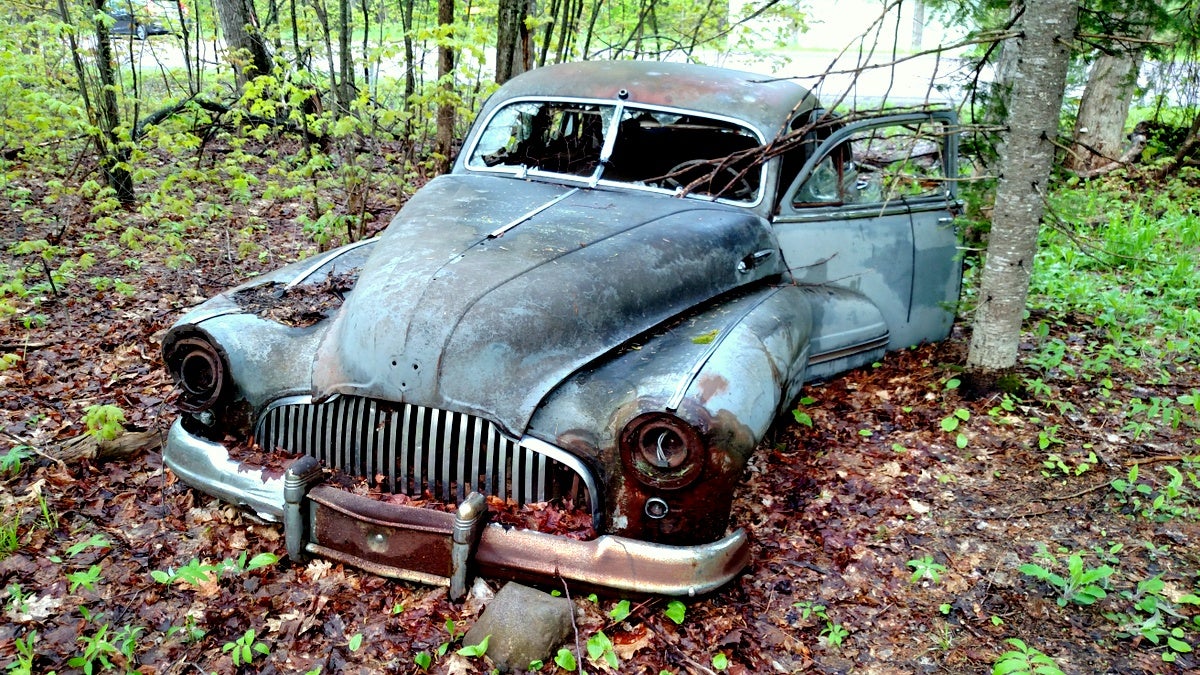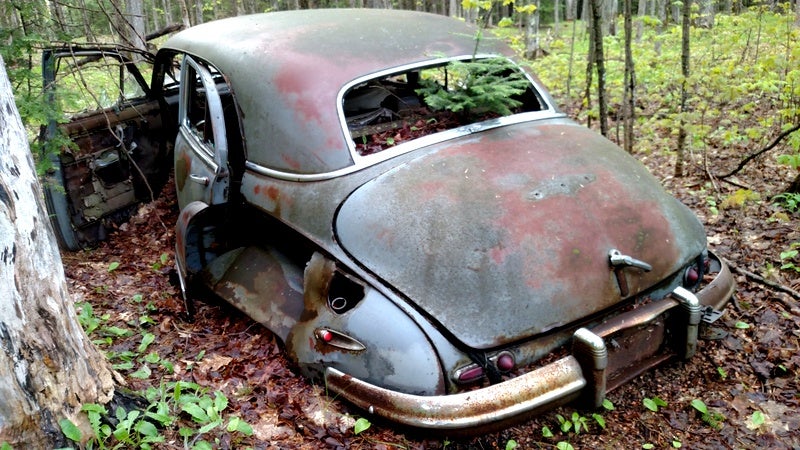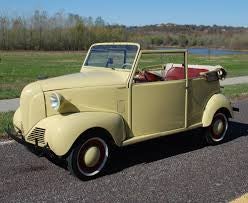 by "SteveLehto" (stevelehto)
by "SteveLehto" (stevelehto)
Published 06/05/2017 at 12:15
 by "SteveLehto" (stevelehto)
by "SteveLehto" (stevelehto)
Published 06/05/2017 at 12:15
No Tags
STARS: 20

I came across a 1942 Buick Super in the woods of Northern Michigan recently. While I am fascinated by any old car I find in the woods, this particular car represented something quite important. It was one of the last cars built by the American auto industry before we tooled up for war – an event that inspired Preston Tucker to start his own car company.
Leading up to the war, seven million Americans worked producing vehicles in one capacity or another. Then, in early 1942, a government department known as the Supply Priorities and Allocations Board ordered the auto industry to stop making cars. The government told auto manufacturers to devote their entire resources to the needs of defense. Car companies ran the last civilian cars off their assembly lines on February 10, 1942.
!!! UNKNOWN CONTENT TYPE !!!
The Buick Super in the woods? It had to have been built prior to February 4, 1942, the last day Buick built cars before the call to arms.
By the time the war ended a little over three years later, the auto industry accounted for 20 percent of all US war production, including half the airplane engines, a third of all machine guns, and every truck the military used. It also manufactured $11 billion in airplanes and related aircraft parts. But no cars had been built for the civilian market.
During the war, Americans were forced to make do with whatever cars they had before the factories were commandeered. By 1945, America’s car population was tired and ragged. Experts counted twenty-four million cars on the road, a third of them worth no more than a hundred dollars. If not for the lack of new cars, most would have been sold for scrap. Automakers realized that this created a vast market for new cars, believing ten million Americans were primed to buy them once they became available.
It was this American thirst for cars which lured Preston Tucker into the automobile manufacturing business. But what about the Buick in the woods?

This particular Buick Super was most likely cherished in the war years and the years that followed. Cars were so valuable during and after the war that it certainly had many good years before it found itself in the woods. This Super carried a $1,381 price tag when new and was one of 16,000 or so produced. Its sibling – the Roadmaster – looks quite similar with the primary difference under the hood. The Super was driven by a 248 cubic-inch straight-eight engine while the Roadmaster carried a 320 cubic-inch straight-eight. The Super weighed 3,863 pounds and seated six quite comfortably.
After a few decades on the road, this Buick Super was unceremoniously pushed into the woods. Its wheels and engine were removed. Badges and ornamentation were pried off. Windows were broken out and now plants grow through the dashboard. Some months, it is not even visible from the road just 20 feet away. But the few people who see it should know that it symbolizes something important. The time when the entire American auto industry came together for the war effort.
Follow me on Twitter: @stevelehto
Hear my podcast on iTunes: Lehto’s Law
Steve Lehto has been practicing law for 25 years, almost exclusively in consumer protection and Michigan lemon law. He wrote The Lemon Law Bible and Preston Tucker and His Battle to Build the Car of Tomorrow.
This website may supply general information about the law but it is for informational purposes only. This does not create an attorney-client relationship and is not meant to constitute legal advice, so the good news is we’re not billing you by the hour for reading this. The bad news is that you shouldn’t act upon any of the information without consulting a qualified professional attorney who will, probably, bill you by the hour.
 "Chariotoflove" (chariotoflove)
"Chariotoflove" (chariotoflove)
06/05/2017 at 12:22, STARS: 2
Great bit of history. Thanks.
 "jimz" (jimz)
"jimz" (jimz)
06/05/2017 at 12:31, STARS: 10
Automakers realized that this created a vast market for new cars, believing ten million Americans were primed to buy them once they became available.
and they were, leading to our economic boom immediately post WWII. Not only did we have millions of Americans with a pent-up need for both cars and other consumer goods, we had thousands of returning servicemen who coincidentally would be needing those jobs manufacturing them. And guess who else would need manufactured goods? Europe and Japan, who were in relative ruins and had to spend most of their resources rebuilding. So we had a couple of decades of prosperity where you could get a decent paying, unskilled job and make a living on it. Unfortunately, too many people believe that it’s something we can go back to, but it isn’t. whether or not you want to blame China, Mexico, automation, or anything.
 "nerd_racing" (nerd189)
"nerd_racing" (nerd189)
06/05/2017 at 13:11, STARS: 1
I mean I suppose you could if you went back into war... I’d prefer not to go there though.
 "Future next gen S2000 owner" (future-next-gen-s2000-owner)
"Future next gen S2000 owner" (future-next-gen-s2000-owner)
06/05/2017 at 14:03, STARS: 2
WWII is the last time anything was really rationed for war. I wonder how society would handle rationing today?
 "SteveLehto" (stevelehto)
"SteveLehto" (stevelehto)
06/05/2017 at 14:06, STARS: 1
Handle it? Most people would freatk out. And if they did implement it, I’m sure we’d find out about all kinds of people who got “exceptions” to it because of their connections and/or money.
 "Berang" (berang)
"Berang" (berang)
06/05/2017 at 16:04, STARS: 1
While I was out at the Lone Star Round Up, there was a Model A ford which still had an “A” ration card in the windshield. It looked original rather than a sticker repro.
If you want to see something interesting, look into the realm of “Victory Bicycles” - bicycles produced by American companies during the war. Chrome and nickel plating was replaced by paint. Rubber hand grips and pedal blocks were replaced by wooden ones. The balloon tires of the 30s were replaced with skinny single-tube types to save rubber.
Bicycle production continued throughout the war to promote conservation of rubber and gasoline, but the bikes were made in limited numbers and often went to official purposes (government couriers etc.) before the rest got to civilians.
 "crowmolly" (crowmolly)
"crowmolly" (crowmolly)
06/05/2017 at 17:33, STARS: 3
People go full nuclear over a bad WiFi signal.
It would not go well.
 "gmporschenut also a fan of hondas" (gmporschenut)
"gmporschenut also a fan of hondas" (gmporschenut)
06/05/2017 at 22:20, STARS: 0

The last car produced in 42 was Crosley, as the factories weren’t big enough to make tanks, planes or other heavy equipment.
neat little car that is as ridicuaously small as one would expect.
 "The Crazy Kanuck; RIP Oppositelock" (jukesjukesjukes)
"The Crazy Kanuck; RIP Oppositelock" (jukesjukesjukes)
06/06/2017 at 02:11, STARS: 0
So this 1942 Ford is pretty rare? http://www.autotrader.ca/a/Ford/Super+Deluxe/Windsor/Ontario/5_31088481_20170106214147965/?showcpo=ShowCPO&orup=37_15_129501
 "SteveLehto" (stevelehto)
"SteveLehto" (stevelehto)
06/06/2017 at 08:05, STARS: 0
Depends on how many were made and how many were left. The car in the piece is not “rare.” It is merely historically significant.